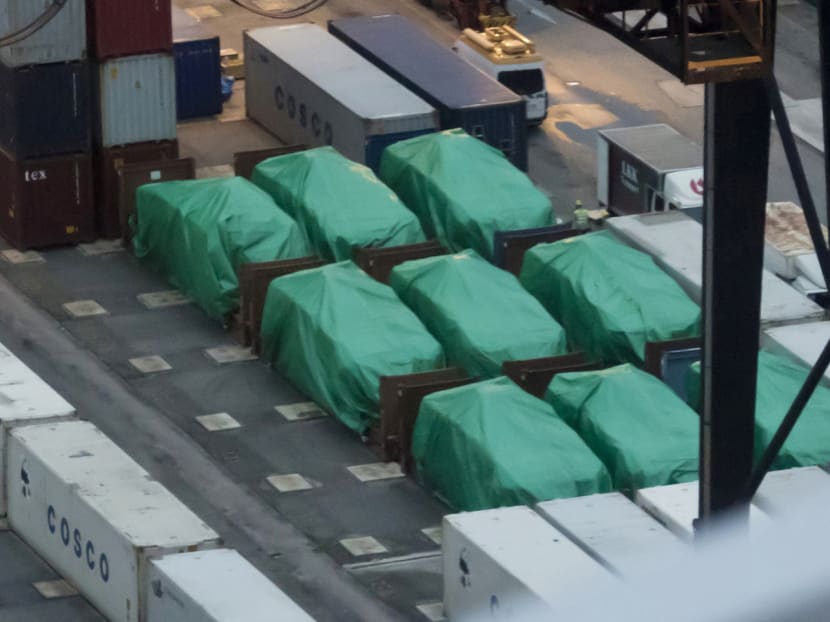The ins and outs of the commercial shipping of military equipment
The detention of nine SAF Terrex Infantry Carrier Vehicles (ICVs) and other equipment by the Hong Kong Customs and Excise Department in November has been in the news, and may have led to misperceptions concerning the shipping process for military equipment. As ex-president of Sembcorp Logistics, I would like to share some insights into the complexity behind the shipping of military equipment.

In this photo taken Thursday, Nov. 24, 2016, Nine eight-wheeled Singapore-made Terrex infantry carrier vehicles are detained at a container terminal in Hong Kong. Photo: AP
The detention of nine SAF Terrex Infantry Carrier Vehicles (ICVs) and other equipment by the Hong Kong Customs and Excise Department in November has been in the news, and may have led to misperceptions concerning the shipping process for military equipment. As ex-president of Sembcorp Logistics, I would like to share some insights into the complexity behind the shipping of military equipment.
Commercial shipping has been a common means of transporting goods for many decades. It is not difficult to understand why it is also one of the most preferred means to ship military equipment for most militaries around the world, whenever the situation permits.
I believe not many militaries own a navy with the capabilities to transport large quantities of military equipment over long distances at an affordable cost. Most militaries, including those of the United States and Australia, would have to rely on the reach and capacity of commercial shipping to transport their military equipment economically.
The shipping of military equipment can be broadly divided into two categories — sensitive items and non-sensitive items. Sensitive items include advanced weapons and ammunition.
Depending on the sensitivity of the equipment, some militaries may choose to place special requirements on the shipping company. These include the crew’s nationalities, country of registration of the carriers, specific routes to take, chartering the whole ship, and even the leasing of a commercial ship for the government’s use.
These would naturally drive up shipping costs significantly. The resulting charges could be many times higher compared with the regular means of buying cargo space on regular shipping lines. For this reason, these special requirements are reserved for highly sensitive equipment. As such, it makes economic sense to make use of regular shipping routes as much as possible.
For the shipping of non-sensitive items such as vehicles and transporters, which the Terrex ICVs fall under, as well as general stores and equipment, regular shipping companies have always been used.
This means that special security clearance and direct-route shipping are not required. Shipping companies would then find the most cost-effective means to ship them, with availability, timings and commercial viability as the main considerations.
Take the analogy of whether one decides to take a bus or a taxi. While the bus is a less costly option, it makes stops along the way, whereas a taxi would take you directly to your location. It is not surprising to hear that the Terrex ICVs went with the “bus” route. After all, shipments of non-sensitive equipment occur far more frequently than those of sensitive equipment, and it is important to be prudent.
The onus lies on freight forwarders and the shipping companies to understand the Customs requirements of each port they are calling at, and apply for the necessary licences and approval. Notwithstanding that these are non-sensitive items, the shipping companies are also responsible for taking special care of the equipment to ensure their smooth transit.
Freight forwarding and shipping require a deep expertise and understanding of the shipping landscape. Given the complexity involved in handling military equipment, challenges naturally arise, which could lead to losses and detention.
One such challenge is in the area of Customs classification and codes, where it is not uncommon for mistakes to be made. For example, while a saloon car is clearly classified as a vehicle, how should it be classified if the car is armour-plated? Should it be classified as a passenger vehicle or military equipment?
This can be quite subjective and oftentimes requires the expertise of freight forwarders and shipping companies to provide the appropriate custom classification, based on the Customs requirements of each port.
After the appropriate classification of goods is done, with input provided by the military agency, the service provider must seek the proper Customs clearance, including applying for the necessary permits and licences.
To better address the challenges, all parties involved in the shipment process have to work closely together and continually improve processes.
Reports have stated that investigations into the detention of the Terrex ICVs are ongoing. Having been once intimately involved in the area of commercial shipping, it is my hope that we can move on from this incident and have the Terrex ICVs returned to Singapore soon.
ABOUT THE AUTHOR:
Koh Soo Keong was President and chief executive of SembCorp Logistics from 1999 to 2006. He is now chairman of Ascendas Reit.






